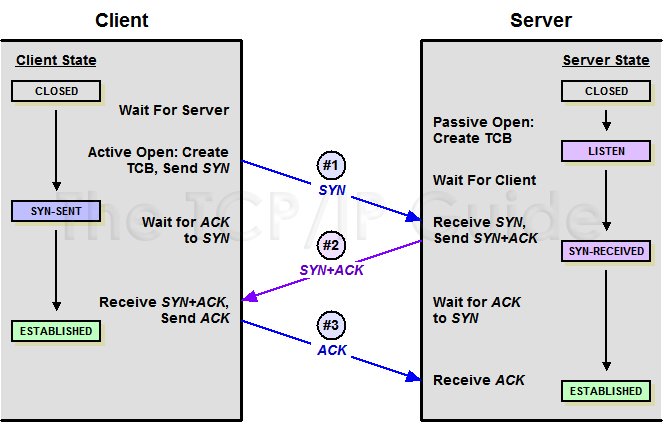TCP Connection Establishment Process: The "Three-Way Handshake"
来源:互联网 发布:openwrt 挂载网络磁盘 编辑:程序博客网 时间:2024/05/21 20:23
Normal Connection Establishment: The "Three Way Handshake"
To establish a connection, each device must send a SYN and receive an ACK for it from the other device. Thus, conceptually, we need to have four control messages pass between the devices. However, it's inefficient to send a SYN and an ACK in separate messages when one could communicate both simultaneously. Thus, in the normal sequence of events in connection establishment, one of the SYNs and one of the ACKs is sent together by setting both of the relevant bits (a message sometimes called a SYN+ACK). This makes a total of three messages, and for this reason the connection procedure is called a three-way handshake.
 Key Concept: The normal process of establishing a connection between a TCP client and server involves three steps: the client sends a SYN message; the server sends a message that combines an ACK for the client’s SYN and contains the server’s SYN; and then the client sends an ACK for the server’s SYN. This is called the TCP three-way handshake.
Key Concept: The normal process of establishing a connection between a TCP client and server involves three steps: the client sends a SYN message; the server sends a message that combines an ACK for the client’s SYN and contains the server’s SYN; and then the client sends an ACK for the server’s SYN. This is called the TCP three-way handshake.
Table 152 describes in detail how the three-way handshake works (including a summary of the preparation discussed in the previous topic). It is adapted from the table describing the TCP finite state machine, but shows what happens for both the server and the client over time. Each row shows the state the device begins in, what action it takes in that state and the state to which it transitions. The transmit and receive parts of each of the three steps of the handshake process are shown in the table, as well as in Figure 211.
Table 152: TCP “Three-Way Handshake” Connection Establishment Procedure
Client
Server
Start State
Action
Move To State
Start State
Action
Move To State
CLOSED
The client cannot do anything until the server has performed a passive OPEN and is ready to accept a connection. (Well, it can try, but nothing will be accomplished until the server is ready.)
—
CLOSED
The server performs a passive OPEN, creating a transmission control block (TCB) for the connection and readying itself for the receipt of a connection request (SYN) from a client.
LISTEN
CLOSED
Step #1 Transmit: The client performs an active OPEN, creating a transmission control block (TCB) for the connection and sending a SYN message to the server.
SYN-SENT
LISTEN
The server waits for contact from a client.
—
SYN-SENT
The client waits to receive an ACK to the SYN it has sent, as well as the server's SYN.
—
LISTEN
Step #1 Receive, Step #2 Transmit: The server receives the SYN from the client. It sends a single SYN+ACKmessage back to the client that contains an ACK for the client's SYN, and the server's own SYN.
SYN-RECEIVED
SYN-SENT
Step #2 Receive, Step #3 Transmit: The client receives from the server the SYN+ACKcontaining the ACK to the client's SYN, and the SYN from the server. It sends the server an ACK for the server's SYN. The client is now done with the connection establishment.
ESTABLISHED
SYN-RECEIVED
The server waits for an ACK to the SYN it sent previously.
—
ESTABLISHED
The client is waiting for the server to finish connection establishment so they can operate normally.
SYN-RECEIVED
Step #3 Receive: The server receives the ACK to its SYNand is now done with connection establishment.
ESTABLISHED
ESTABLISHED
The client is ready for normal data transfer operations.
ESTABLISHED
The server is ready for normal data transfer operations.
Figure 211: TCP “Three-Way Handshake” Connection Establishment Procedure
This diagram illustrates how a conventional connection is established between a client and server, showing the three messages sent during the process and how each device transitions from the CLOSED state through intermediate states until the session is ESTABLISHED.

From:http://www.tcpipguide.com/free/t_TCPConnectionEstablishmentProcessTheThreeWayHandsh-3.htm
- TCP Connection Establishment Process: The "Three-Way Handshake"
- TCP Three Way Handshake
- TCP Three-Way handshake
- 3-way TCP connection establishment
- TCP三次握手(Three-way Handshake)
- 三次握手Three-way Handshake
- TCP 3 way handshake
- The Four-Way Handshake
- Connection Establishment in TCP 2
- TCP三次握手过程详解(二) three way handshake of TCP
- socket 编程入门教程(三)TCP原理:5、TCP的三次握手(three-way handshake)
- 著名的三次握手(three-way handshake)
- 18 TCP Connection Establishment and Termination
- Establishment of a TCP connection, state diagram
- 18-TCP Connection Establishment and Termination
- The Process of TCP Connection and State Transfer
- TCP 3次握手模式(3-WAY HANDSHAKE)
- TCP/IP 详解 卷1 ch18 TCP Connection Establishment and Termination
- kong API gateway(二):添加API
- Matlab 方程组求解
- 进程间通讯-——管道
- 游戏化学习
- Kylin增量cube build的restAPI的时间不准确的BUG
- TCP Connection Establishment Process: The "Three-Way Handshake"
- 小米4A安装App报错INSTALL_FAILED_VERSION_DOWNGRADE
- Java-JDK-Serializable
- Ubuntu下Qt creator无法使用fcitx输入中文之解决办法
- I2C 上拉电阻取值
- 001-javaweb项目各个目录的作用
- Spring框架之AOP面向切面编程
- opencv目标识别之HMM 模型(隐马尔可夫模型)
- Java导出Excel文档(poi),并上传到腾讯云对象存储服务器


